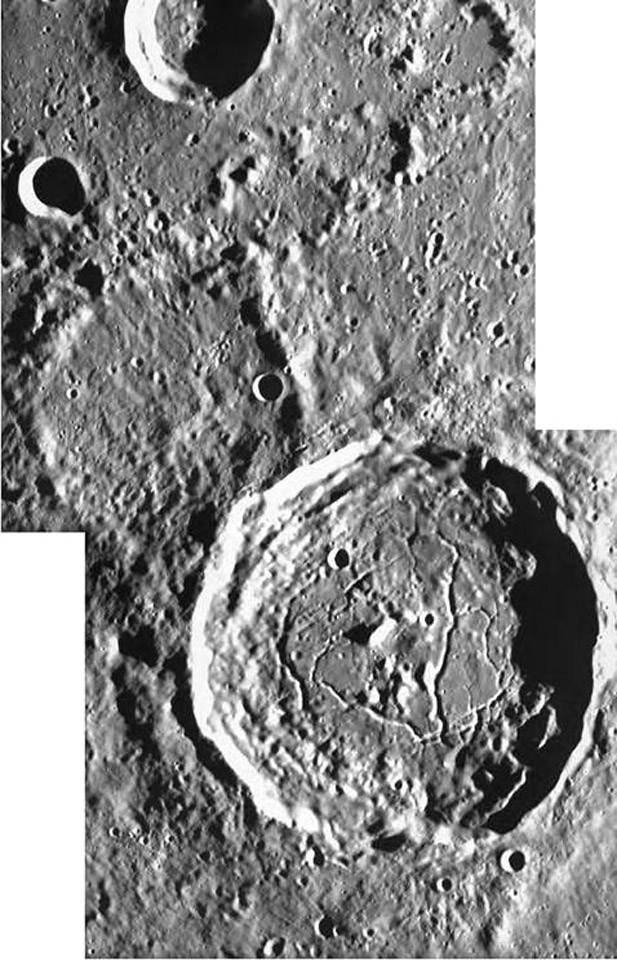|
|
| (6 intermediate revisions by the same user not shown) |
| Line 1: |
Line 1: |
| | __NOTOC__ | | __NOTOC__ |
| | =Atlas Alone= | | =Atlas Alone= |
| | + | <!-- Start of content --> |
| | <div class="post" id="post-184"> | | <div class="post" id="post-184"> |
| | | | |
| Line 6: |
Line 7: |
| | <p>[[File:Atlas-SPOT.jpg|ATLEAS-SMART]]<br /> | | <p>[[File:Atlas-SPOT.jpg|ATLEAS-SMART]]<br /> |
| | <em>image by [http://www.space-x.ch/Amie_Crater_Atlas.htm ESA/SPACE-X, Space Exploration Institute]</em></p> | | <em>image by [http://www.space-x.ch/Amie_Crater_Atlas.htm ESA/SPACE-X, Space Exploration Institute]</em></p> |
| − | <p>Can you image a twin alone? Sabine without Ritter? Atlas without [http://www.lpod.org/?m=20060129 Hercules]? Well here is the latter. This is another SMART-1 image that was not released on the ESA website but is on the ESA/SPACE-X site, the company that built the camera. Atlas is 87 km wide with a steep rim crest that gives way to partly slumped wall terraces. The real interest of Atlas is its criss-crossed floor. A strongly defined rille cuts north to south and a narrower family of rilles circles the floor. Atlas is a [http://www.lpod.org/cwm/DataStuff/ffc.htm floor-fractured crater] (ffc), as we have said before. But this photo brings to mind another question - what is the nature of the smooth material on the floor of Atlas that is cut by the rilles? Considering that ffc are modified by volcanism - witness the dark halo craters on the northern and southern sides of the floor - the expectation is that the smooth material is volcanic. But a high Sun [http://www.lpi.usra.edu/resources/cla/info/bi/ image] shows only the two dark halo craters as dark - the rest of the floor is bright. The smooth material is not mare lava, but could it be lava of a different composition? This is an unanswered question for lunar science. </p> | + | <p>Can you image a twin alone? Sabine without Ritter? Atlas without [[January_29,_2006|Hercules]]? Well here is the latter. This is another SMART-1 image that was not released on the ESA website but is on the ESA/SPACE-X site, the company that built the camera. Atlas is 87 km wide with a steep rim crest that gives way to partly slumped wall terraces. The real interest of Atlas is its criss-crossed floor. A strongly defined rille cuts north to south and a narrower family of rilles circles the floor. Atlas is a [http://www.lpod.org/cwm/DataStuff/ffc.htm floor-fractured crater] (ffc), as we have said before. But this photo brings to mind another question - what is the nature of the smooth material on the floor of Atlas that is cut by the rilles? Considering that ffc are modified by volcanism - witness the dark halo craters on the northern and southern sides of the floor - the expectation is that the smooth material is volcanic. But a high Sun [http://www.lpi.usra.edu/resources/cla/info/bi/ image] shows only the two dark halo craters as dark - the rest of the floor is bright. The smooth material is not mare lava, but could it be lava of a different composition? This is an unanswered question for lunar science. </p> |
| | <p>[mailto:tychocrater@yahoo.com Chuck Wood]</p> | | <p>[mailto:tychocrater@yahoo.com Chuck Wood]</p> |
| | <p><b>Technical Details:</b><br /> | | <p><b>Technical Details:</b><br /> |
| | 3 February 2006. Advanced Moon micro-Imager Experiment (AMIE) camera on SMART-1 spacecraft.</p> | | 3 February 2006. Advanced Moon micro-Imager Experiment (AMIE) camera on SMART-1 spacecraft.</p> |
| − | <p><b>Yesterday's LPOD:</b> [[April 2, 2006|A Widget for Lpod]] </p> | + | <p><b>Related Links:</b><br /> |
| − | <p><b>Tomorrow's LPOD:</b> [[April 4, 2006|Keeping Up with the Smythiis]] </p> | + | Rükl plate 15</p> |
| − | <!-- Removed reference to store page -->
| + | <p><b>Yesterday's LPOD:</b> [[April 2, 2006|A Widget for LPOD]] </p> |
| | + | <p><b>Tomorrow's LPOD:</b> [[April 4, 2006|Keeping up with the Smythiis]] </p> |
| | </div> | | </div> |
| − | ----
| + | <p> </p> |
| − | ===COMMENTS?===
| + | <p> </p> |
| − | Register, and click on the <b>Discussion</b> tab at the top of the page.
| + | <p> </p> |
| − | <hr> | + | <!-- End of content --> |
| − | <!-- | + | {{wiki/ArticleFooter}} |
| − | You can support LPOD when you buy any book from Amazon thru [[Support_ LPOD|LPOD]]!
| |
| − | -->
| |
| − | <span style="font-size:88%"> | |
| − | <center> | |
| − | Contributions to http://www2.lpod.org/ are licensed under a Creative Commons Attribution No-Derivative-Works Non-Commercial 3.0 License. [http://www.creativecommons.org/licenses/by-nc-nd/3.0 http://www.wikispaces.com/i/creativecommons/by-nc-nd_3.0_80x15.png]<br>
| |
| − | </center>
| |
| − | </span>
| |




